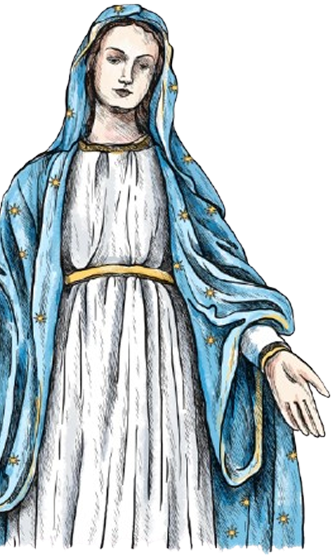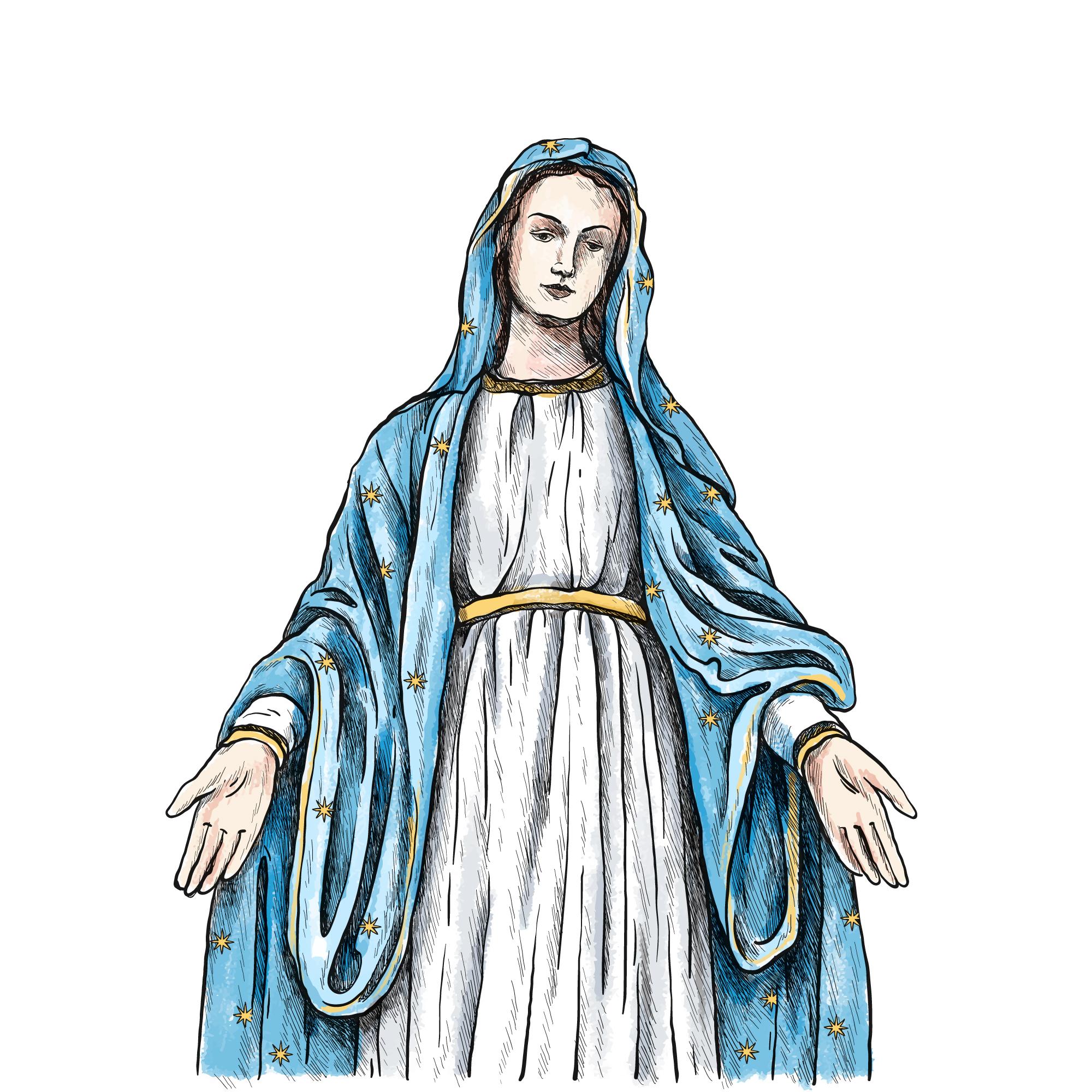
What is the Catholic Church?
"Go, therefore, and make disciples of all nations, baptizing them in the name of the Father, and of the Son, and of the Holy Spirit."- Matthew 28:19
"God, infinitely perfect and blessed in himself, in a plan of sheer goodness freely created man to make him share in his own blessed life. For this reason, at every time and in every place, God draws close to man. He calls man to seek him, to know him, to love him with all his strength. He calls together all men, scattered and divided by sin, into the unity of his family, the Church. To accomplish this, when the fullness of time had come, God sent his Son as Redeemer and Savior. In his Son and through him, he invites men to become, in the Holy Spirit, his adopted children and thus heirs of his blessed life."
(Catechism of the Catholic Church)

The Church
The church is described as one having four marks: One, Holy, Catholic and Apostolic

The Church is "one" because her founder is Christ himself.
"There is one body and one Spirit, just as you were called to the one hope that belongs to your call, one Lord, one faith, one baptism, one God and Father of us all, who is above all and through all and in all" (Ephesians 4:5). In Christ, we are united by our profession of one faith, our common celebration of worship and apostolic succession (CCC, 815).
Saint Paul describes the Church as a body. Bodies have many different parts that make up the whole (1 Corinthians 12:14-18). Without the veins, the heart cannot function. Without blood, neither the heart nor the veins can function. Without the heart, the whole body cannot live. In a similar way, the Church is comprised of many members, all of whom serve different roles (1 Corinthians 12:28-30). The Pope is the visible head of the Church on earth, the bishops and the priests are her ministers, the consecrated and religious men and women serve the Church through vows of poverty, chastity and obedience, and the laity fulfill their own mission while pursuing temporal affairs.
The Eucharist
"For my flesh is true food, and my blood is true drink." (John 6:55)
The Eucharist is the center of the Catholic Church because Jesus Christ is the center of the Catholic life and worship. The Church proclaims, as it has for almost 2,000 years, that the Eucharist is the body, blood, soul and divinity of Jesus Christ himself.
In the celebration of the Eucharist, bread and wine become the Body and Blood of Jesus Christ through the power of the Holy Spirit and the instrumentality of the priest. The whole Christ is truly present - body, blood, soul, and divinity - under the appearances of bread and wine, the glorified Christ who rose from the dead. This is what the Church means when she speaks of the "Real Presence" of Christ in the Eucharist.
The Lord Jesus, on the night before he suffered on the cross, shared one last meal with his disciples. During this meal our Savior instituted the sacrament of his Body and Blood. He did this in order to perpetuate the sacrifice of the Cross throughout the ages and to entrust to the Church a memorial of his death and resurrection.
Jesus gives himself to us in the Eucharist as spiritual nourishment because he loves us. By eating the Body and drinking the Blood of Christ in the Eucharist, we become united to the person of Christ through his humanity. "Whoever eats my flesh and drinks my blood remains in me and I in him" (John 6:56). In being united to the humanity of Christ, we are at the same time united to his divinity. Our mortal and corruptible natures are transformed by being joined to the source of life.
The transformed bread and wine are truly the Body and Blood of Christ and are not merely symbols. When Christ said “This is my body” and “This is my blood,” the bread and wine are transubstantiated. Though the bread and wine appear the same to our human faculties, they are actually the real body and blood of Jesus.
By his Real Presence in the Eucharist Christ fulfils his promise to be with us "always, until the end of the age" (Mt 28:20). As St. Thomas Aquinas wrote, "It is the law of friendship that friends should live together. . . . Christ has not left us without his bodily presence in this our pilgrimage, but he joins us to himself in this sacrament in the reality of his body and blood" ( Summa Theologiae, III q. 75, a. 1). With this gift of Christ's presence in our midst, the Church is truly blessed. As Jesus told his disciples, referring to his presence among them, "Amen, I say to you, many prophets and righteous people longed to see what you see but did not see it, and to hear what you hear but did not hear it" (Mt 13:17). In the Eucharist the Church both receives the gift of Jesus Christ and gives grateful thanks to God for such a blessing. This thanksgiving is the only proper response, for through this gift of himself in the celebration of the Eucharist under the appearances of bread and wine Christ gives us the gift of eternal life. (USCCB)
The Hierarchy
Why is the Church structured as it is?

Some people object to the Catholic Church because of her hierarchical structure. The Church may seem to be only an external institution, rather than an organic, living body. But the hierarchy of the Church is not simply arbitrary, but comes from Christ himself, who established the apostles as the ones who would pass on the Catholic faith.
Thus, the Second Vatican II document, Lumen Gentium (the Dogmatic Constitution on the Church), explains, "For the discharging of such great duties [passing on the faith], the apostles were enriched by Christ with a special outpouring of the Holy Spirit coming upon them, and they passed on this spiritual gift to their helpers by the imposition of hands, and it has been transmitted down to us in episcopal consecration" (art. 21). In other words, Christ himself is the one who ordains his ministers through apostolic succession.
Thus, the hierarchy of the Church is not imposed or man-made; rather, Christ himself, as the Great High Priest (Hebrews 4:14), established the hierarchy.


Moreover, there is collegial union between the Pope and the bishops. The Pope is the visible head of the universal Church, while the individual bishops are the visible head of their own dioceses.
However, "all of them together and with the Pope represent the entire Church in the bond of peace, love and unity" (Lumen Gentium, art. 23). For this reason, a "particular church" cannot depart from the universal Church in its own ideas or practices. The particular churches must remain in union with the universal Church, which means they must remain in union with the Chair of Peter, the Pope. While some may object that this unity means conformity, Lumen Gentium explains, "This variety of local churches with one common aspiration is splendid evidence of the catholicity of the undivided Church" (Lumen Gentium, art. 23).

The bishops possess the threefold office of sanctifying, teaching and governing: "Bishops, in an eminent and visible way, sustain the roles of Christ himself as teacher, shepherd, and high priest" (Lumen Gentium, art. 21). Bishops are the image of the Pope for their particular church, and in a special way, the image of Christ. The flock of the church follows the local bishop. He teaches them the way to follow Christ and the way to fulfill their own vocation within the Church, depending on their state in life. He gives them the sacraments, especially the sacrament of the Eucharist, to nourish them and lead them into eternal life.
Finally, he governs his diocese, and ensures that all are following the law of the Church and the law of Christ. Thus, the bishop holds a very distinguished place in the Church, being a public sign for the faithful of the proper way to know, love, and serve Christ.

